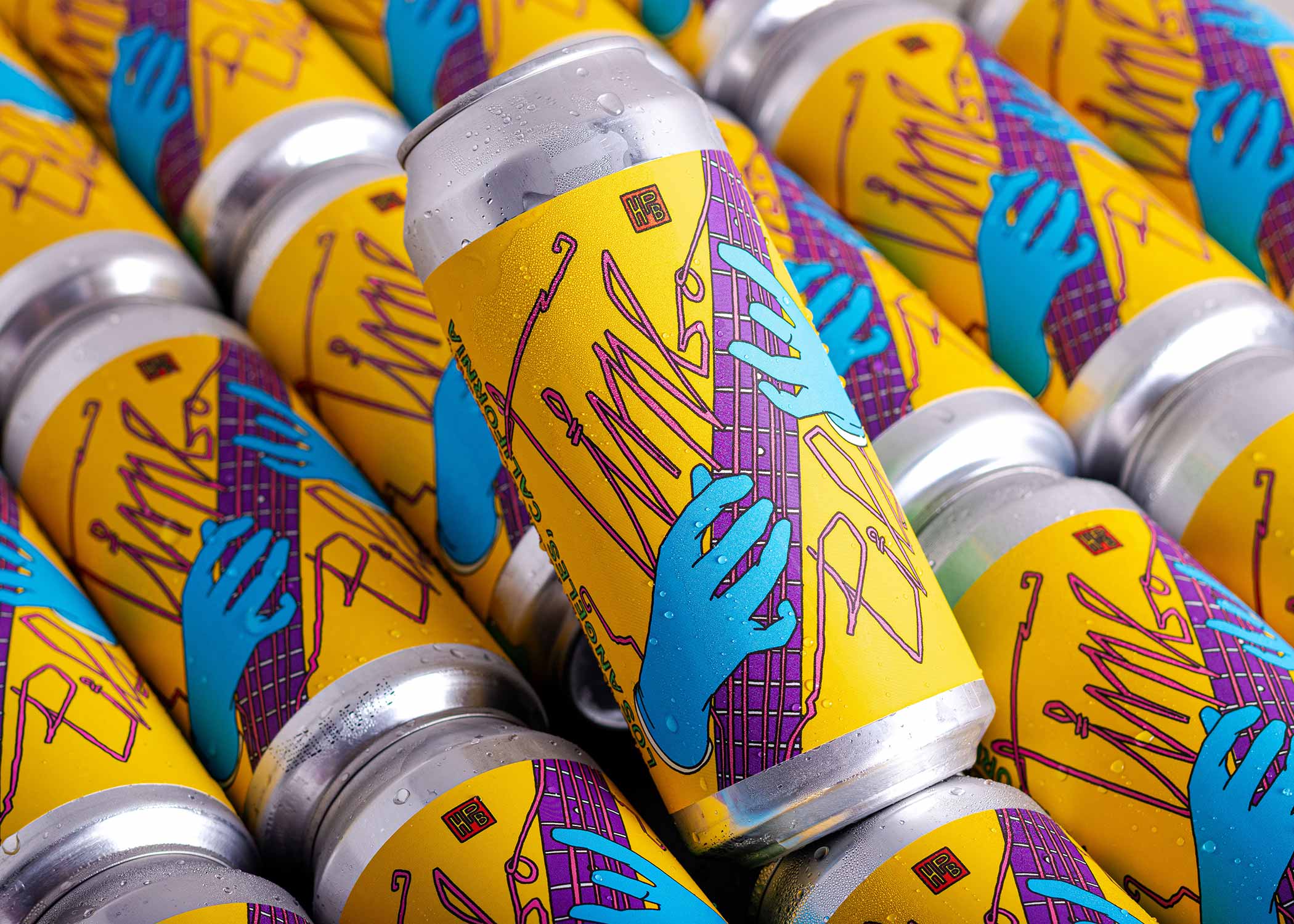Shop
The Cult of Underberg: What Is in Those Tiny Brown Bottles?
Twist, slap, drink, repeat!
Hop Culture's Favorite "Cult Of" Stories:
Unwrap the brown paper, unscrew the plastic green cap, slap the little amber bottle down on the table, pick it up with your mouth, and let the collection of bitters and herbs in this digestif drip down your throat. You’ve just drunk an Underberg.
But what exactly is this mysterious liquid? For years now, in America, these ubiquitous bottles have graced tables at beer bars, stood at attention like a line of infantry soldiers behind the bar, and captivated drinkers around the world.
But this German digestif has actually been around for over 175 years. In Europe, people sipped the herbal bitters after a meal (not taken like a shot, as Americans have been wont to do). “Underberg is an all-natural digestive made to be enjoyed after a great meal,” wrote Udo Bruns, Underberg’s Director International, in an email to Hop Culture. “It is a pure herbal bitter consisting of natural herbal extracts, alcohol, and water.”
So what is it about Underberg that has inspired a generation of fervent fans and ‘Berg believers?
Perhaps it’s in the brand’s motto: “It cannot be explained; it must be experienced.” Well, maybe you’ve been lucky enough to enjoy Underberg, but if not, we’ll do our best to explain it.
Today, Underberg has become a favorite amongst industry folks to nurse a hangover, drinkers to revel in during nights out, and even mixologists to design new cocktails.
We wanted to look at the crazy and wacky history of a drink that, honestly, many people might not have even heard of yet.
Let’s peek under the hood of Underberg.
A Brief History of Underberg
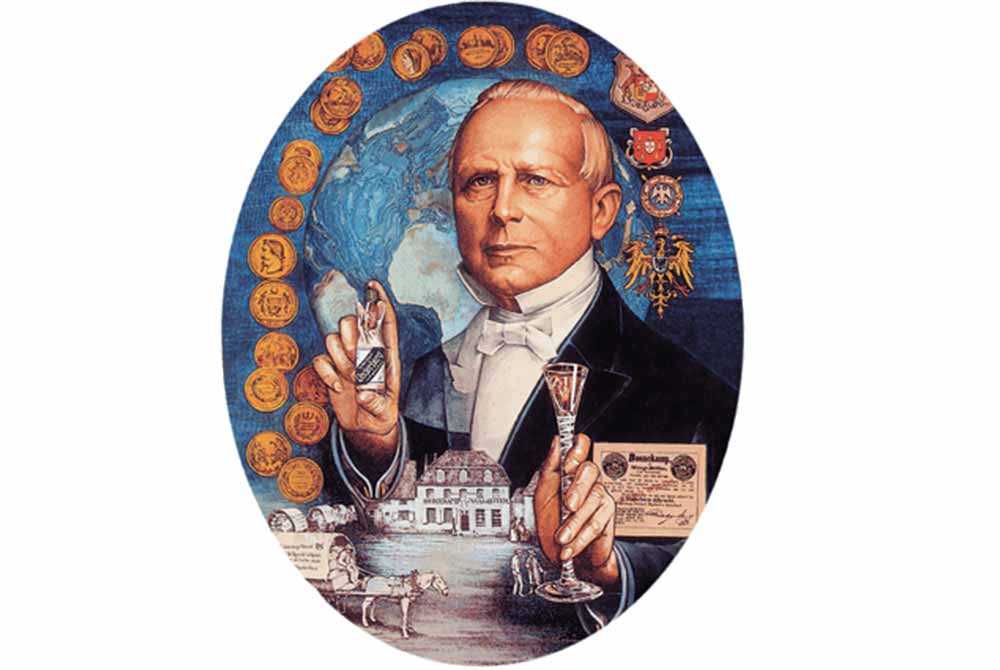
Images courtesy of Underberg
In 1846, Hubert Underberg launched his company Underberg-Albrecht. For years, Hubert had been a fan of genever, a juniper-flavored gin, and the herbal drinks made with it around the Netherlands and Belgium.
However, Hubert had trouble finding a consistent, delicious product.
So, perhaps very smartly, he created his own. One focused on high-quality ingredients and production methods.
That mission is written right into Underberg’s creed. Known as SEMPER IDEM or “always the same quality and effect,” the secret techniques used to make Underberg have been passed down through five generations of the Underberg family.
And it is still a secret to this day.
Wait, So What Exactly Is Underberg?
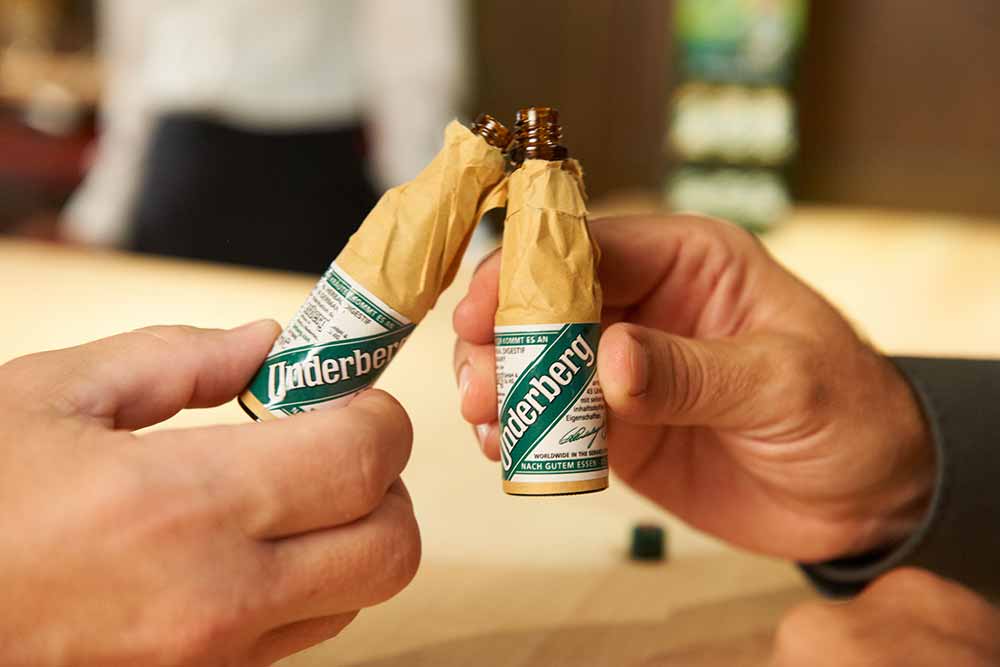
Photography courtesy of Underberg
Well, we don’t have a definitive answer for you because the recipe and production method remain a secret, known only by three people in the Underberg family and two clerics to ensure the preservation of Underberg for the future.
But we can tell you this: Underberg is considered a German bitter or digestif usually taken after eating. As it says directly on the label, “Underberg: After a good meal. Underberg is an herb bitters taken for digestion; it is not a beverage. Not to be supped, but taken all at once and quickly because of its aromatic and strong taste.”
Aged for several months in Slovenian Oak and made of herbs and spices from forty-three different countries, the liquid is hugely herbal, slightly spicy, and lightly licorice-y.
“The special feature of Underberg lies in the herbs from 43 countries, which pass on their natural extracts to the drink in several process steps,” writes Bruns. “Each initiated family member practices these steps in their own individual way according to the traditional specifications of the company founder. That’s what makes it so special.”
When you first take a whiff inside the bottle, you might find something similar to Christmas—pinecone, nutmeg, cinnamon, clove, and allspice.
“The most accurate way you can describe it is saying it’s a bitter shot,” says Emily Morton, general manager of The 126, a curated cocktail bar in Burlington, VT. “It’s like when you jump into really cold water. It may not be nice at first, but eventually, you’re into it.”
So Is It a Spirit? A Bitter? A Liqueur? A Digestif?
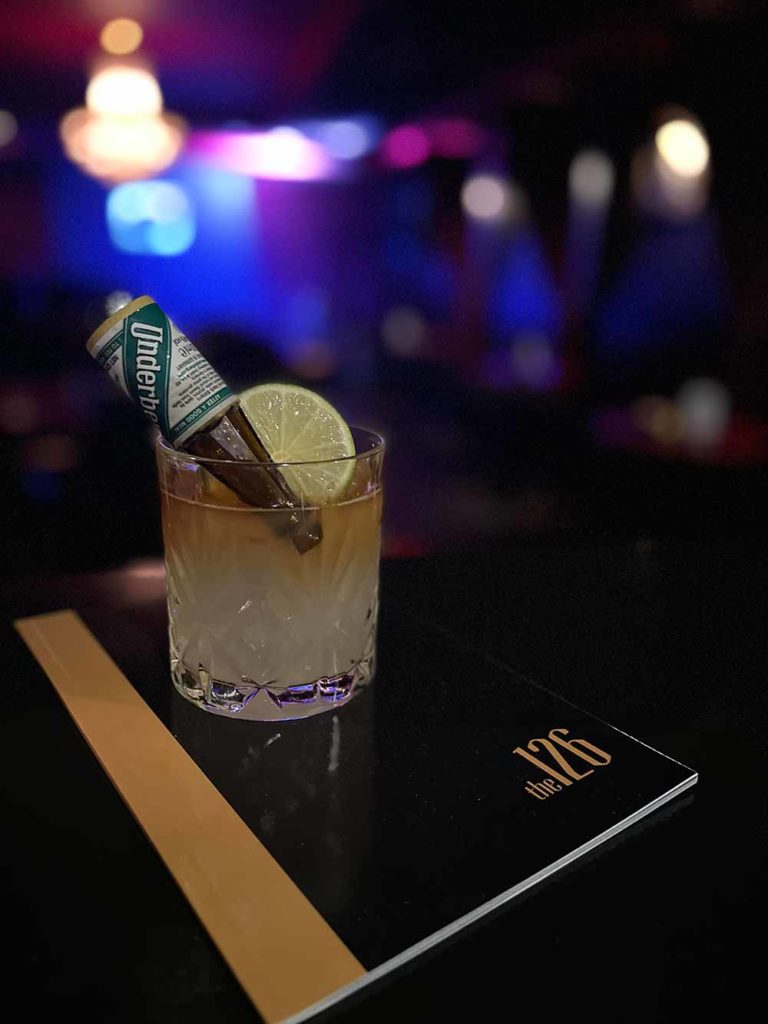
Photography courtesy of Emily Morton | The 126
Technically, yes to all the above (more on this later).
Bottled at forty-four percent alcohol and part of a category of spirits known as Kräuterlikör (herbal liqueur), Underberg is often compared to Italian bitters such as Amaro or maybe even Fernet or Jägermeister. Although it’s a lesser-known spirit, Underberg has carved out a distinctive place in drinking culture.
Morton first discovered Underberg online while researching bitters. She decided to give it a try, buying a case on Amazon. The results of her taste test? “Well, this was frickin’ hilarious and wonderful,” says Morton.
Few people around Morton in Vermont had heard of Underberg then, so she introduced her clientele to it via a clever cocktail. The pineapple daiquiri with freshly squeezed pineapple juice, rum, and lime also included a whole (tiny) bottle of Underberg tipped upside down. A la a “Coronita” (a margarita with a tiny bottle of Corona flipped upside down inside of it), the “Bergita” would fill up with Underberg the more you drank it.
According to Morton, The 126 sold a lot of Bergitas. People saw the cocktail coming out with a tiny bottle inside and wondered about it, ordering the cocktail themselves.
And then, eventually, just the bottle of Underberg.
What Does Underberg Taste Like?
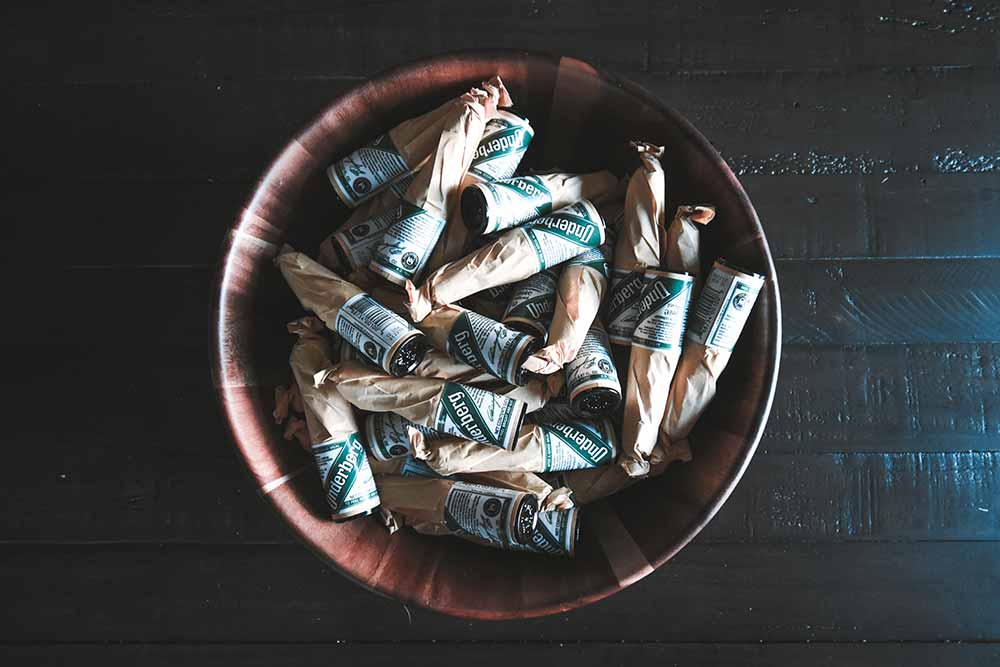
Photography courtesy of Underberg
Not much exists on this planet that tastes like Underberg.
“There are many bitters and digestives on the market, however, there is hardly a bitters with so many herbs included as ingredients that are left natural,” writes Bruns. “Despite the bitter substances, you can taste them, and they are so pleasant afterward.”
Morton expands, “You get those super cooling, bitter … almost wintergreen, lasting, lingering flavor that tingles your tongue and palette. Then this weird what-the-hell-is-this flavor along with some blend of fruits and things.”
According to Morton, she picks up on some chicory and licorice levels that you often find in holiday goods. “You get that linger that isn’t as bitter or intense and minty but more Christmas herbs and spices.”
And the more Underberg drips into your mouth, the more your taste buds drop down the rabbit hole. “With each drop, you experience something different,” says Morton. “That’s part of the reason why Underberg is so unique.”
Unique in flavor and packaging (see below), Underberg quickly developed a cult-like following.
Underberg Became an Instant Hit
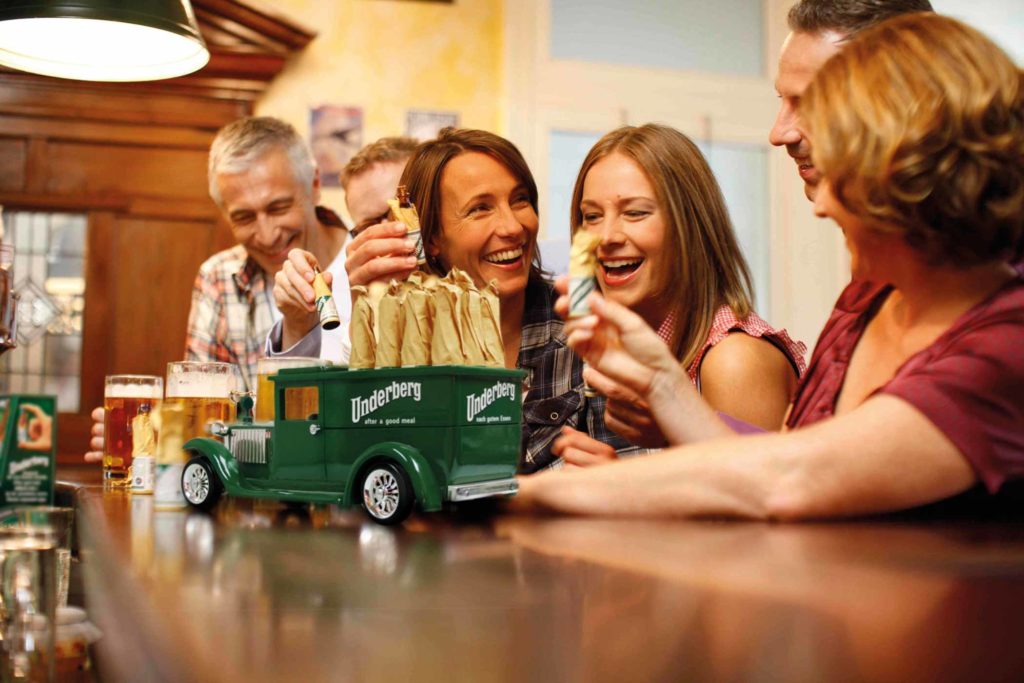
Photography courtesy of Underberg
From the beginning, Underberg began racking up awards, winning medals at the World Exhibitions in London, Paris, and Philadelphia in the mid-nineteenth century.
The herbal elixir developed such a following that by 1860, Underberg appeared in America for the first time, arriving at a port in San Francisco.
Before long, the German digestif had spread across America.
And perhaps ironically, its popularity only grew during Prohibition. Why?
Well…
Technically, Underberg Isn’t Considered Alcohol
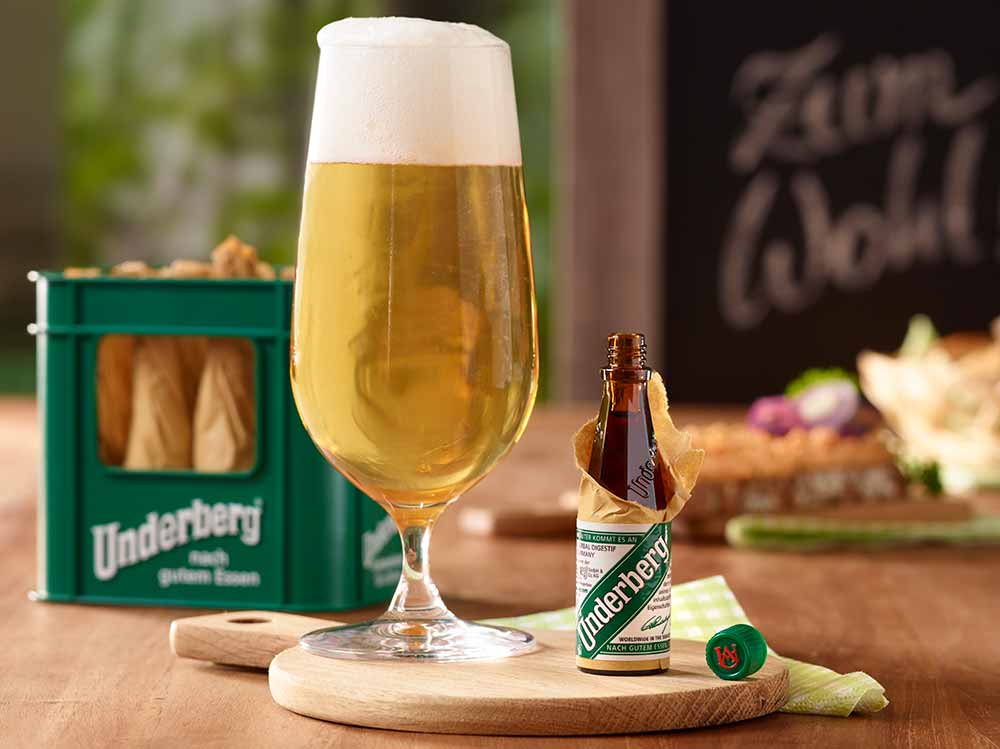
Photography courtesy of Underberg
Huh? Didn’t you just say Underberg is everything from an herbal liqueur to a German bitter and digestif?
Yes, we did. However, the United States Food and Drug Administration (FDA) has a different definition.
Classified by the FDA as a food product, Underberg isn’t technically considered alcohol in America. For that reason, importers could continue to ship Underberg to the United States even during Prohibition legally.
Meaning people could continue to legally drink the digestif even when the U.S. government forbade every other form of alcohol for public consumption in the United States for fourteen years.
Call it a small consolation, literally.
What’s Up with the Tiny Bottles and Brown Paper Packaging?
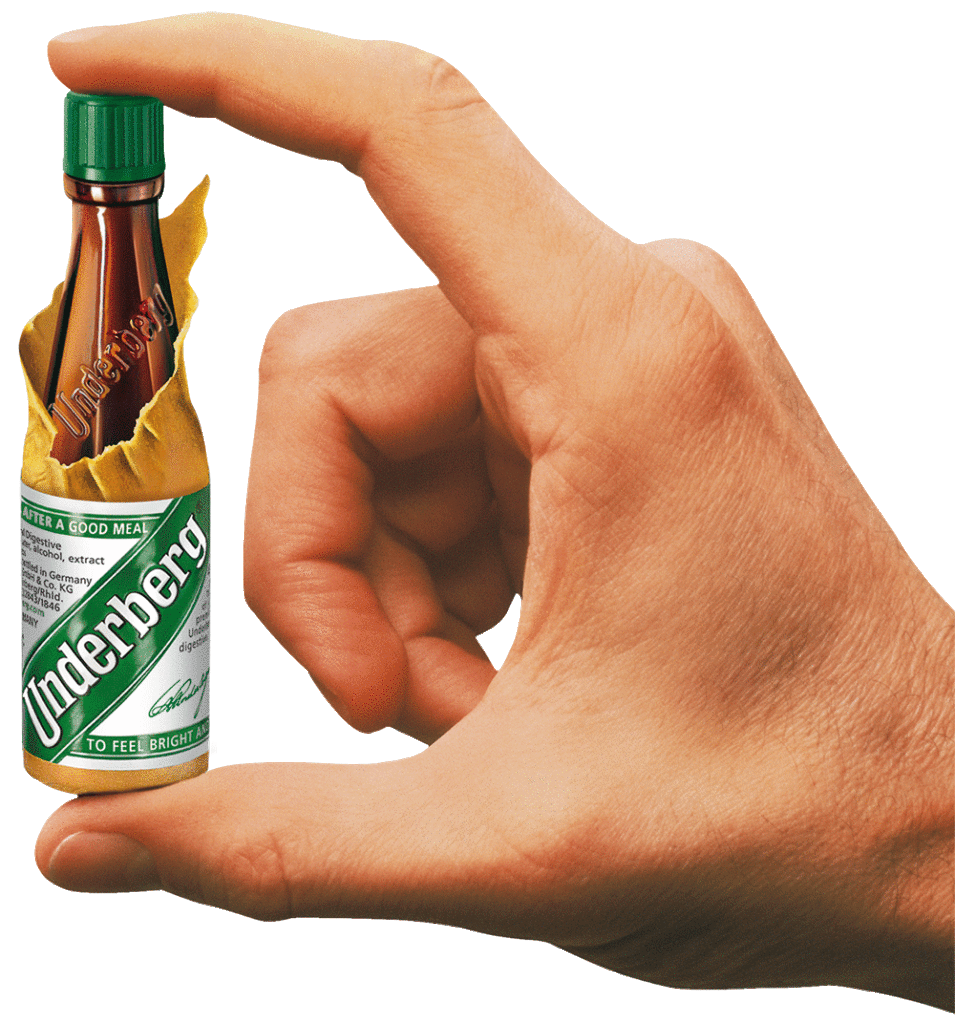
Photography courtesy of Underberg
In fact, the tiny amber bottles the Underberg family uses today didn’t enter the production process until 1949.
Before the mid-twentieth century, Underberg sold its liqueur in a variety of different bottle sizes.
But, World War II brought about a change in packaging. With materials and ingredients such as herbs diverted for the war effort, Emil I. Underberg (Hubert’s grandson) decided to use a small, single-serving 20mL bottle “so that every customer with little money could afford an Underberg because of the economically difficult times,” writes Bruns. “The wrapped portion bottle has remained the most recognizable feature of the brand icon to this day.”
The distinctive packaging also helped deter counterfeit products. And the tiny size made it perfect for traveling.
You’ll also notice that bottles come wrapped in brown paper. This material protects the digestif from environmental contamination, such as sunlight and heat.
It’s just one of the many quirks that make Underberg unique.
How Should I Drink Underberg?
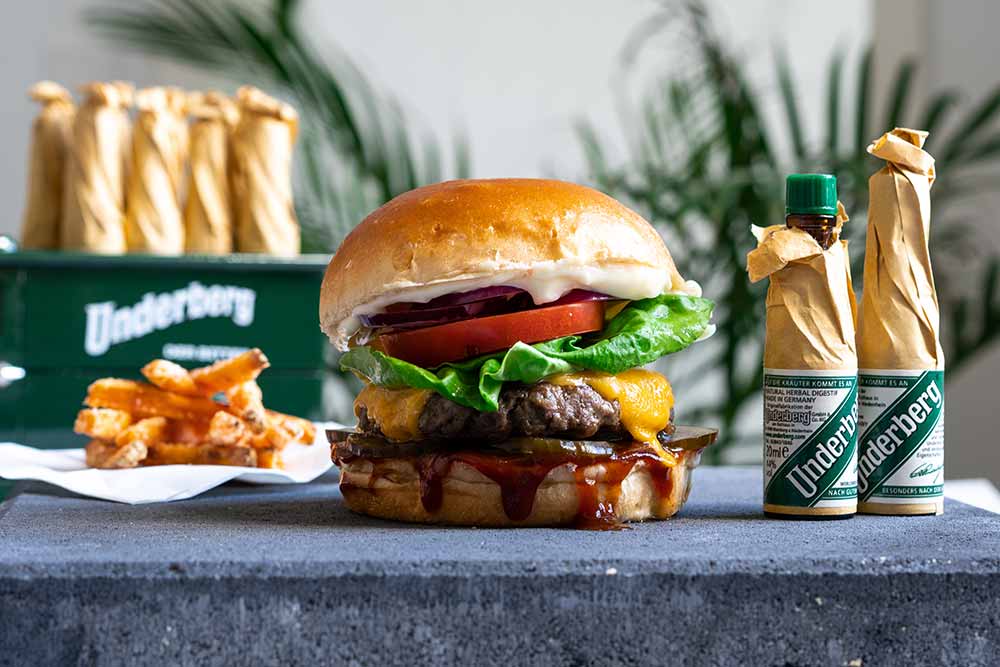
Photography courtesy of Underberg
How you drink Underberg is another eccentricity.
Initially considered a medicinal beverage, Germans and Europeans sipped on Underberg after a meal to help with digestion.
“The beginning way of drinking Underberg is to stick a straw in it and suck it down because you don’t experience it quite as much,” says Morton.
If you drink it straight from the bottle, Underberg specifically designed the tapered neck of the bottle to ensure that the liquid would slowly drip out of the bottle, allowing the drinker to imbibe the herbal liquid inside slowly.
Purists of this beverage go even further, saying that the best technique for drinking Underberg is in a special glass.
Developed by Hubert Underberg and glassblowers from Murano, Italy, the small tulip bowl gives way to an unusually long-stemmed glass (24 cm).
“[Hubert] cheered them on to blow longer and longer stems,” writes Bruns. The twenty-four-centimeter neck makes this the longest drinking [glass] in the world.”
The glass’ shape is meant to accentuate the aromas as Underberg reaches your palette. It also holds a perfect single portion of the bitters.
Plus, the vessel looks super unique. When it debuted at the World Exhibition in Paris in 1867, let’s just say it turned heads and continues to do so to this day.
But the head-turning glass isn’t the only way to drink Underberg.
Here in the United States especially, drinking an Underberg has morphed into a sort of ritual.
Slap the green-capped bottle down on the table, tip it back with just your mouth at a forty-five-degree angle (if you’re a traditionalist, no hands here!), and let the cooling liquid drip down your throat.
This ritual is just one part of what has made Underberg so popular.
What Else Made Underberg So Popular?
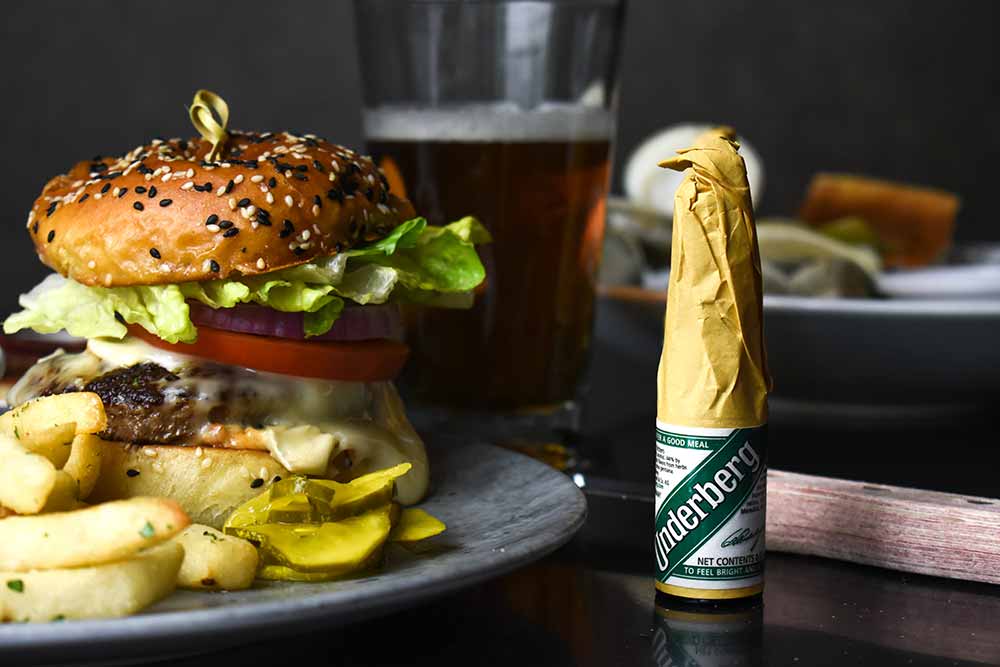
Photography courtesy of Underberg
“Perhaps the greatest trick the devil ever pulled was convincing the world he didn’t exist,” said Kevin Spacey’s character Verbal Kent in the Academy Award-winning movie “Usual Suspects.”
Perhaps Underberg followed a similar mantra. This German bitter has an air of mystery that surrounds it, giving it a special mystique.
If you’re in the know…you’re in the know. And if you’re not, well, you better find someone who is to initiate you.
What exactly lies behind that straw-colored paper in those tiny bottles littered across table tops? And what goes into the secret recipe?
“I would argue few other brands have done as good a job as Underberg at not marketing the product as much as marketing the package,” says Morton. “Instead of traditionally selling it as the best thing ever … it’s this mysterious thing that comes in a bottle where you can’t see what’s inside and you can’t easily drink it. … They’ve made it into a thing.”
Call it a right of passage to drink an Underberg. Much like if you live in Chicago, shooting Malort is this baptism by fire to the local drinking culture.
Tipping back one of these tiny brown bottles seems to give you the key into an almost secret society, an exclusive club full of the fervent few. However, in reality, Underberg now has millions of fans across the globe.
“What is that behind the bar? What is in the packaging? There is a question generator and intrigue generator [with Underberg] because you see this bottle, and everyone is like, let me tell you about this secret … cool thing.”
The Swag Game Is Unparalleled
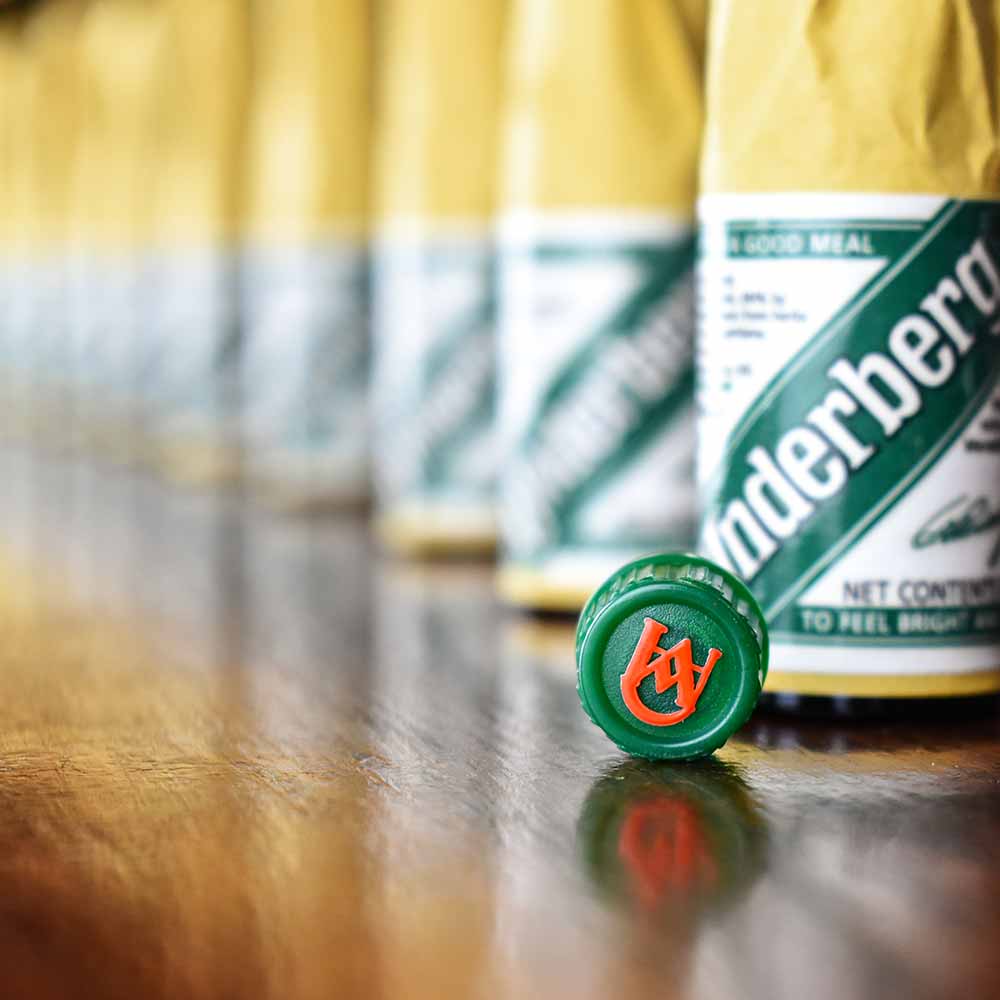
Photography courtesy of Underberg
To cap it all off, Underberg developed a creative rewards program called “Tops & More.”
Emil I. Underberg launched the program in 2002 to answer the question: How can the company stay in touch with its customers?
The concept is simple: Collect a certain number of caps and turn them in for rewards.
We’re talking about dope gear.
Everything from small tchotchkes like keychains and decks of cards (worth 48 caps) to serious swag like the special engraved Underberg glasses (range from 96 to 144 tops depending on whether you want an engraving) or a model Underberg car (Underberg Kräuter-Mobil) that holds up to twelve single-portion bottles in its trunk.
At The 126, Morton collected enough caps to grab the model car. We’re more impressed by this feat because they added a personalized license plate (336 caps). Luckily, they received the music box trailer (approximately 288 caps) from their distributor rep as a gift for purchasing so much of the herbal liqueur.
“When something new (or in this case old) comes along where you can collect these tops, try to save 100 of them in your purse, get a piece of swag, it’s like, ‘Wow, you drank a lot of Underberg; you committed long enough to get this piece of swag,’” says Morton.
We find the proof in the caps. According to Bruns, in January 2009, fans returned more than one million caps per month to the company. “Since then, it has been mathematically correct to say that a cap is collected every three seconds,” writes Bruns. In 2021, during the program’s twentieth anniversary, Underberg shipped its one-millionth reward.
The Future of this German Digestif
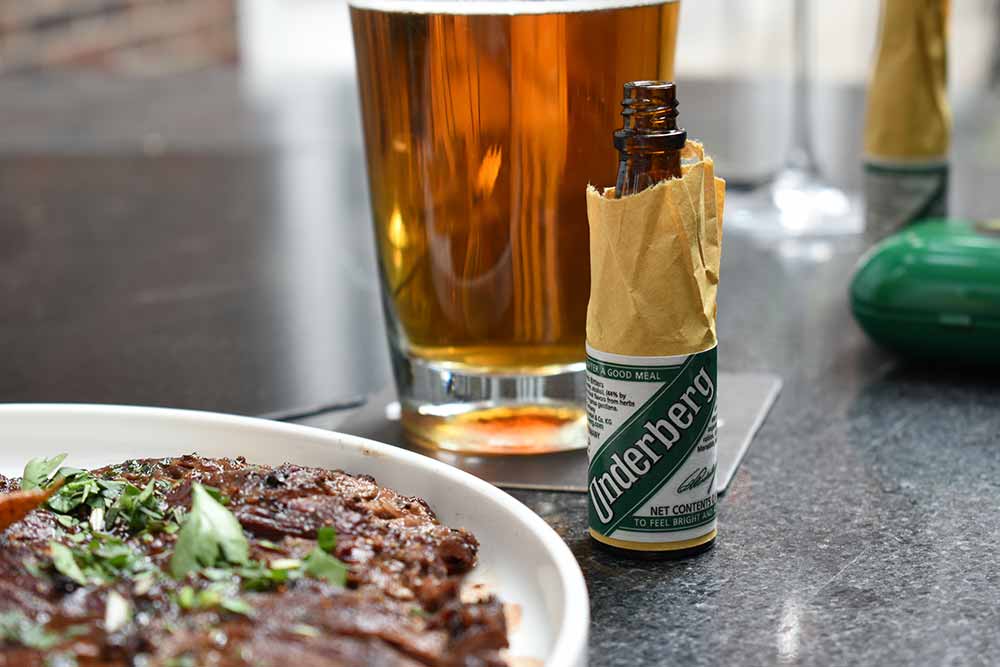
Photography courtesy of Underberg
For over 175 years, Underberg has enjoyed success as a herbal digestif.
Yet, the company still finds ways to innovate. Bruns Underberg’s fairly new design, for example, brought a “Pop art meets German romanticism” to the brand.
Most recently, the liqueur has even wound its way into modern cocktail culture, with major mixologists at bars such as the James Beard Award-winning The Violet Hour in Chicago putting their spin on the unique bitter.
It may seem like this drink is currently riding a trend train, but those devoted to the brand will continue to bring people into its clandestine circle for life.
“Similarly to other cocktail trends, Underberg will blow up and … go crazy for a year, and something else will come around, but people who get into it will stay into it,” says Morton. “There’ll probably be a swell that will happen, and if you didn’t know about Underberg, you will now know about it, but it has been centuries of a following that [is] not going away.”
Whether drunk after a meal as a medicinal beverage or slurped shot-like on bar tables, Underberg is undeniably a cult favorite.
One that will remain mysteriously popular for years to come.
Now go forth, unwrap that brown paper, slam those amber bottles, tip back that herbal bitter, and collect those green bottle caps.
Are you a ‘Berg believer yet?



